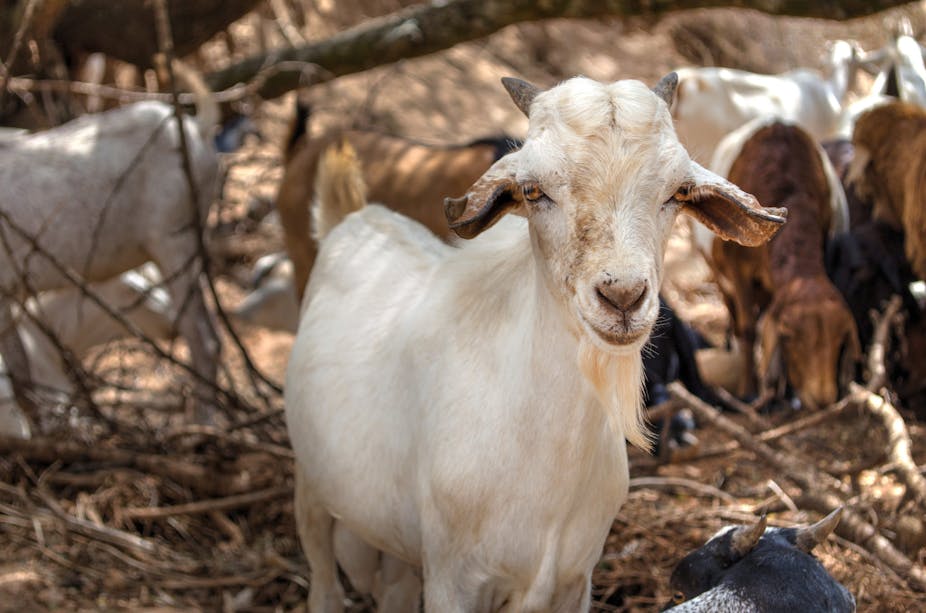Small ruminant farming in the Democratic Republic of Congo (DRC) accounts for more than 72% of household incomes yet it’s under threat from a disease known as ‘goat plague’, or peste des petits ruminants. The Conversation Africa’s Samantha Spooner asked Ahadi Birindwa about the plague and what’s being done to stop it.
What is the ‘goat plague’ and how widespread is it?
Peste des petits ruminants (PPR) or ‘goat plague’ is an acute viral disease that affects domestic (sheep, goats) and wild (springbok, gazelles and impala) small ruminants. These are animals that bring up food from their stomach and chew it again.
It’s one of the most damaging animal diseases, affecting small ruminants in almost 70 countries in Africa, the Middle East and parts of Asia. PPR has a high morbidity, or incident, (80-90%) rate and mortality (50-80%) rate. It’s more severe in young animals, those with poor nutrition and concurrent parasitic infections.
It causes $1.5 - 2 billion in losses each year in regions that are home to over 80% of the world’s sheep and goats. The disease is not zoonotic – in other words it doesn’t affect people. But it affects food security and the livelihoods of the poorest small-scale holder farmers. As a result it’s among the priority diseases indicated in a global framework dedicated to the control of trans-boundary animal diseases.
How is the virus spread? How contagious is it?
Transmission of PPR is achieved by either direct contact with infected animals, or through breathing or contact with saliva. There have also been documented cases of transmission through the handling of contaminated animal products.
Because it’s so contagious, about one million goats and 600,000 sheep in the Democratic Republic of Congo (DRC) are at risk of contracting the disease. This represents a quarter of goats and two-thirds of sheep throughout the entire country. Prevalence is particularly high in eastern DRC.
Reports show that the DRC has been infected with goat plague since 2008. Between 2010 - 2012, it caused the death of almost 120,000 small ruminants. The annual direct loss – the value of dead sheep and goats – is estimated at $5.3 million.
Where in the country are animals most affected?
Animals are most affected in the eastern part of the country, the South Kivu region. At 65% of the goat and sheep population, prevalence is high. Especially in Shabunda (56.5%), Mwenga (54%), Fizi (40.8%) and Kalehe (20.3%) territories. Some cases have also been reported in the West.
As the disease is a trans-boundary disease, there’s a concern that it will spread to neighbouring counties as well as countries such as Rwanda and Burundi which have never had reports of it before.
There’s therefore a need for proper diagnostic, control and surveillance at a national and international level.
How important is small livestock farming in the Democratic Republic of Congo?
Goats and sheep are the animals of choice for around 80% of farmers. Goats are known as the “poor-man’s cow” in the DRC, contributing more than 72% to the household income. Goats and sheep are the animal of choice for around 80% of farmers.
Goats are popular because they cost less so families use them to build herds, they are a good source of milk, fibre, skin and meat and they provide organic manure. They also have cultural and social importance as they, along with cattle, are used at wedding ceremonies.
However, despite their importance, DRC’s small ruminant population has gone down from 5.7m in 1998 to 4.4m in 2014. The disease is a major contributor to this.
What steps are being taken to eradicate the disease?
The research project I am working on looks at the control, surveillance and eradication of goat plague in the DRC.
So far I’m looking at the status of the disease. I have collected samples (blood, tissues, swabs and serum) from both infected and uninfected goats and sheep in areas that have experienced outbreaks.
As a result I have been able to diagnose and characterise the virus strains that are circulating in the DRC. I have also been able to establish sero-epidemiology - that is the prevalence of non-vaccinated animals that have antibodies against the disease. This has enabled me to create a map of high risk areas and identify major risk factors related to the disease.
All of these will help with the design of a control, vaccination and surveillance strategy. The next step will be to establish an information centre, vaccines, a surveillance program and post vaccination evaluation. Other research that’s needed is that on vaccines - to help identify genes that are resistant to the disease with a view to create a locally adapted breed.

